Are you a beginner gardener looking for easy and beginner-friendly garden designs to create a beautiful outdoor space? Look no further – I’ve got you covered with this start-to-finish guide!
Designing a garden can be a fun and rewarding experience for beginners. Before jumping into the process, it’s important to learn about your garden space and take things slow. Understanding the aspect of your garden, the movement of the sun, and whether it is windy or sheltered will help you make informed design decisions. Zoning your garden into different areas based on your preferences and needs will help create a cohesive design. It’s also important to consider wildlife and create a garden that is welcoming to them.
Trees are essential in every garden, even small ones, as they add beauty and require low maintenance. When it comes to the actual design, it’s important to choose a style that complements your home and to create outdoor rooms. By focusing on scale, color, and plant groupings, beginners can create beautiful garden designs. It’s also important to consider how you want to use your garden and who will be using it.
Prioritizing your efforts and starting slow is key, as it allows you to assess your interests and determine if you truly enjoy gardening. Assessing the conditions of your garden, including the amount of sunlight it receives, will help you choose the right plants for your space. Taking the time to plan and design a garden will result in a beautiful and enjoyable outdoor space for beginners.
Key Takeaways:
- Understanding your garden space is important before making any design decisions
- Zoning your garden into different areas based on your preferences and needs helps create a cohesive design
- Consider wildlife and create a garden that is welcoming to them
- Trees are essential in every garden, even small ones
- Focus on scale, color, and plant groupings to create beautiful garden designs
- Assess the conditions of your garden to choose the right plants for your space
- Starting slow and prioritizing your efforts is key for beginners
Understanding Your Garden Space
Before diving into garden design, it’s crucial to familiarize yourself with the unique characteristics of your garden space. Understanding your garden size and layout, as well as its sun and shade patterns, is essential to creating a successful garden design.
Start by sketching out your garden and noting any fixed features, such as trees, sheds, or paths. This will help you visualize the layout and plan accordingly. Understanding the aspect of your garden will also help you make informed decisions. Observing the movement of the sun and identifying areas that are mostly in sun or shade will aid in choosing appropriate plants for your garden.
When selecting plants, it’s important to consider the windiness or sheltered nature of your garden. Choose plants that can withstand the conditions of your garden and place furniture accordingly. Creating zones in your garden based on how you plan to use the space can help you prioritize and design accordingly.
Additionally, creating a garden that is welcoming for wildlife is important. Avoid using plastic and harmful chemicals, and include trees in your garden to add beauty and provide shade. When designing your garden, keep in mind the style of your house and create outdoor rooms that complement your home.
Focus on three key design principles: scale, color, and plant groupings. Pay attention to the mature size of plants, create a cohesive color palette, and plant in natural-shaped drifts. Prioritize your efforts and start with the areas that are most visible or important to you. Assess the conditions of your garden, including light levels and existing plantings, and make decisions accordingly.
Remember, it’s okay to start slowly and build upon your gardening skills and designs over time. With these garden design tips for novices, starting a garden for beginners has never been easier.
Understanding Sun and Shade Patterns in Your Garden
Understanding the sun and shade patterns in your garden is vital for designing a thriving outdoor space. As a beginner, it’s important to take the time to study the layout of your garden and how sunlight and shade move throughout the day. This will help you make informed decisions when selecting plants and determining the placement of furniture and other outdoor elements.
Start by sketching out the main sections of your garden and noting any fixed elements, such as patios or large trees, that will affect the sun and shade patterns. Use a compass app to determine the aspect of your garden, which will determine the amount of sunlight it receives. North-facing gardens receive the least amount of sun, while south-facing gardens receive the most.
Observe the movement of the sun throughout the day to identify areas that are mostly in sun or shade. This will help you create different zones in your garden based on how you want to use the space. Zoning your garden based on sun and shade patterns will help you create different sections for various purposes, such as a vegetable garden, family dining area, or play area.
Additionally, consider the wind patterns in your garden, as this can affect plant growth and the placement of furniture. Wind can be beneficial for plants, but too much wind can damage young plants and knock over furniture.
When designing your garden, it’s important to remember that gardens are not just for humans, but also for wildlife. Creating a garden that is welcoming for wildlife is not only enjoyable, but also essential for maintaining the ecosystem. Incorporating trees into your garden is also recommended, as they provide shade and can enhance the overall aesthetics.
When choosing plants for your garden, assess the amount of sunlight and shade each area receives to choose plants that will thrive in the given environment. Focus on three design principles: scale, color, and plant groupings. Scale refers to the mature size of plants, so make sure to choose plants that fit the available space. Create a color palette of 1-3 colors for each section of your garden to create harmony. When planting, group plants in natural-shaped clumps to mimic nature.
As a beginner, it’s important to prioritize and start with one area of the garden, such as the front yard, before moving on to other areas. This will help you avoid feeling overwhelmed and give you the opportunity to learn and grow as a gardener.
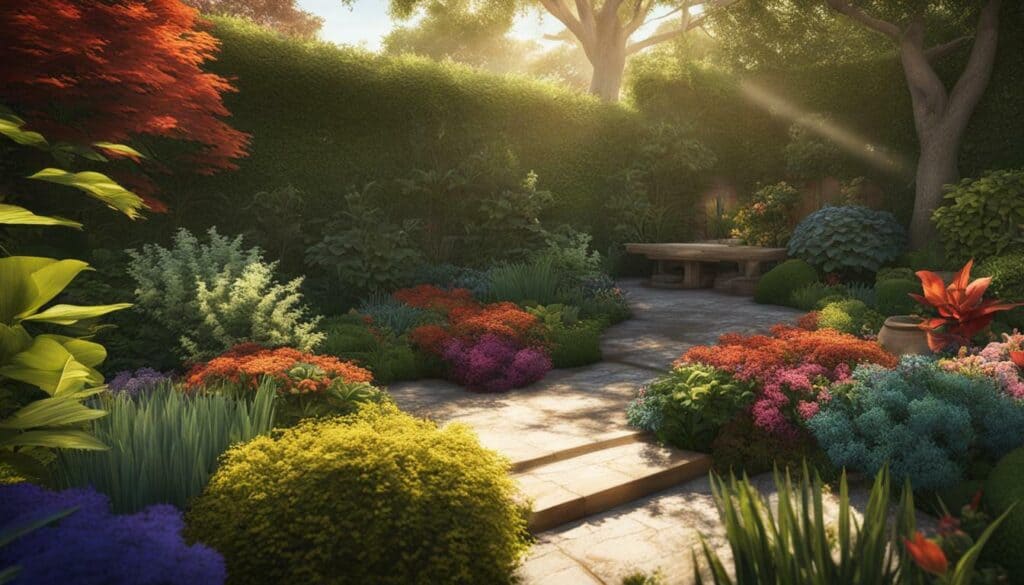
Considering Wind and Shelter
Don’t overlook the wind and shelter factors when planning your garden – they impact both the comfort and success of your outdoor oasis. When designing your garden, it’s important to take into account the aspect and microclimates of the space. North-facing gardens receive the least amount of sun, while south-facing gardens receive the most. East and west-facing gardens fall in between.
Observing the movement of the sun and noting which areas are mostly in sun or shade can help in choosing plants suitable for the different zones. It’s also important to consider the wind conditions in the garden, as this can affect plant growth and the placement of outdoor furniture. Urban gardens tend to be more sheltered, while gardens on hills or near the coast may be windier.
A well-designed garden should also complement the style of the house and consider the needs and preferences of the people using it. Creating zones in the garden and having a variety of plantings, including trees, will help provide shelter and a welcoming environment for wildlife.
Prioritizing and starting slowly can be a good approach for beginners, allowing them to learn and enjoy the process of gardening. By taking the time to carefully consider wind and shelter factors, your garden will not only look beautiful but also thrive.
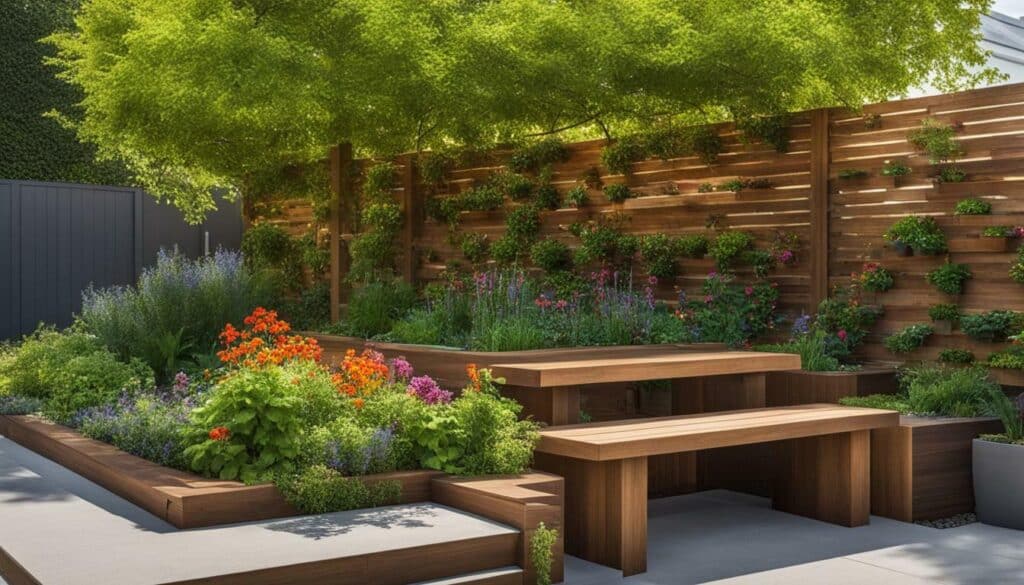
Creating Functional Garden Zones
To make the most of your garden, it’s essential to create distinct functional zones that cater to your specific needs and desires. Whether you want to grow your own vegetables or create a space for outdoor entertaining, dividing your garden into different areas can help you achieve your goals. Before you start planning your garden zones, it’s important to assess the characteristics of your garden space.
| Design Tips for Novices: |
|---|
| Determine the aspect of your garden to observe the movement of the sun. |
| Consider wind and shelter when choosing appropriate plants and furniture placement. |
| Create different zones based on how you want to use the space. |
| Embrace wildlife-friendly design to support a diverse range of wildlife. |
Once you have a good idea of the characteristics of your garden, it’s time to start creating functional zones. This can include a vegetable garden, a family dining area, a kids’ play area, or a space for outdoor entertainment. Choosing appropriate plants, furniture, and decor can help bring these zones to life and create a space that caters to your specific needs.
When designing your garden zones, it’s important to consider the principles of garden design. This includes choosing a style that complements the style of your house and creating outdoor rooms that define different areas of the garden. Scale is also an important factor to consider, as planting trees or shrubs that are too large can overwhelm the space. Choosing a color palette and grouping plants based on their water needs can create a natural and cohesive look.
Starting a garden can be overwhelming, but it’s important to prioritize and focus on the areas that are most visible and important. This could mean starting with the front yard and gradually expanding to other areas of the garden. By taking it slow and following these steps, you can create functional and beautiful garden zones that cater to your specific needs and desires.
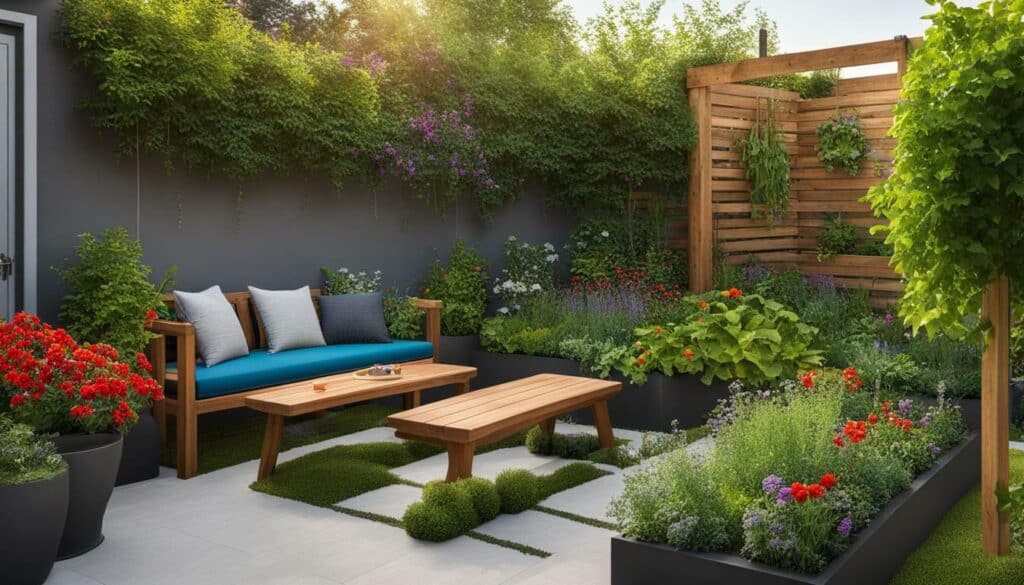
Embracing Wildlife-Friendly Design
A garden that nurtures wildlife not only enhances biodiversity but also adds a touch of magic to your outdoor sanctuary. As a beginner gardener, it may be tempting to focus solely on aesthetics. However, designing a garden that is welcoming for wildlife is crucial for the health of our environment and ecosystems. By considering the needs of wildlife and incorporating sustainable practices, beginners can create a beautiful and functional garden that benefits both humans and nature.
When designing a garden, it is important to avoid plastic products and pesticide use. Instead, opt for sustainable alternatives like natural mulch and compost. These practices not only benefit the environment but also promote healthy soil and plants.
Consider incorporating trees and wildlife areas into your garden design. Trees provide shade and shelter for a variety of wildlife species, while also adding beauty and structure to the garden. Wildlife areas, such as birdhouses and pollinator gardens, provide essential habitats for a variety of animals and insects.
It is also important to learn about your garden space and take into account factors such as aspect, sun movement, and wind exposure. By understanding these elements, you can create a garden that is best suited for your specific environment and can provide the necessary resources for wildlife.
Designing the garden in zones and including elements like vegetable gardens, play areas, and dining spaces can make the space functional for both humans and wildlife. A vegetable garden can provide a food source for both humans and animals, while a play area can provide a safe space for children to connect with nature.
By prioritizing the needs of wildlife and designing with them in mind, homeowners can create a garden that is not only beautiful but also beneficial for the environment. In doing so, beginners can contribute to the preservation and promotion of biodiversity in their own backyard.
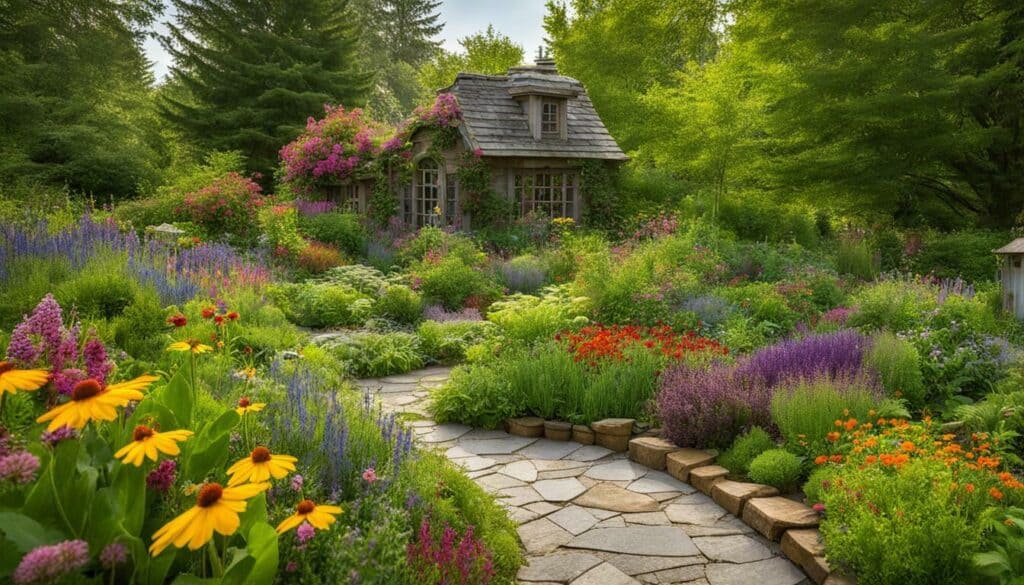
The Beauty and Utility of Trees
Don’t underestimate the impact of trees in your garden – they bring both beauty and practicality to your outdoor oasis. Not only do they add visual interest and texture, but trees also serve important purposes such as providing shade, attracting wildlife, and creating privacy.
When planning your garden, it is essential to consider the aspect of the garden and the movement of the sun. This will help determine the best locations for trees and other vegetation, as well as the best orientation for seating areas and other garden features. Additionally, it is important to be mindful of the level of exposure to wind when choosing which trees to plant. Slow-growing trees with sturdy trunks are ideal for windy areas, while fast-growing trees may be more appropriate for sheltered areas.
Zoning your garden into different areas, such as a vegetable garden or a family dining area, can help create a more functional and well-designed space. When creating zones, be sure to consider the natural conditions of the space, such as the topography and existing vegetation. Incorporating trees into each zone can help create a cohesive and harmonious design.
Prioritizing the inclusion of trees in your garden is important, as they add a natural and low-maintenance element to the landscape. Trees can also help create focal points in the garden and add depth to the space. Whether you have a large yard or a small patio, there are trees that can be incorporated into any garden design.

When preparing your garden space, be sure to prioritize clean up, weeding, edging, and mulching. These steps will help create a tidy and well-maintained garden that will serve as the perfect backdrop for your trees and other plantings.
Assessing the conditions of your yard, such as sunlight and existing plants, can also help determine the best approach to designing and maintaining a garden with trees. By prioritizing and focusing on one area at a time, such as starting with the front yard, you can avoid feeling overwhelmed and ensure that your garden is a source of joy and relaxation for years to come.
Design Principles: Scale, Color, and Groupings
To create a visually stunning garden, incorporating design principles such as scale, color, and plant groupings is crucial. When considering the scale of plants, it is important to think about how they will fit into the overall design. Understanding the mature height and width of plants can help you avoid planting trees that will be too tall for small spaces or shrubs that will quickly outgrow their allotted area.
Color selection is also key in garden design. Creating a color palette of 1-3 colors for each section of the garden helps to avoid a chaotic mix of colors that can be overwhelming to the eye. Consider the color of foliage, flowers, and even hardscaping materials such as pavers or walls when creating your palette.
In addition to scale and color, grouping plants together in drifts rather than in straight rows creates a more natural and visually appealing garden. This allows for a more organic flow and can create a sense of movement throughout the space.
It is also important to take the time to clean up and maintain the garden regularly. This includes tasks such as weeding, edging, and pruning. By doing so, you can make sure that your garden always looks tidy and well-cared for. Lastly, assessing conditions such as light and existing plants can help you make informed decisions when selecting appropriate plantings for your garden.

Incorporating these design principles into your garden planning can help you create a beautiful and functional garden that you can enjoy for years to come.
Preparing Your Garden Space
Before bringing your garden designs to life, it’s essential to prepare your garden space for optimal growth and beauty. As a beginner, it’s important to learn about your garden space before making any design decisions. Start by understanding its size, aspect, and how the sun moves throughout the day. Sketching out your ideas can help you plan the different sections of your garden and take into account fixed elements like patios or large trees.
Another important consideration is the wind conditions in your garden. Is it sheltered or exposed? This will help you determine the right plant and furniture placements. When designing your garden, think about how you want to use the space and create zones for different purposes. Make a list of elements you want to include, such as a vegetable garden, dining area, or play area for children.
If you’re a beginner, it’s important to prioritize and start slowly. Focus on cleaning up and maintaining your garden before taking on more elaborate designs. Assess the conditions of your garden, including the amount of sunlight it receives, and choose plants accordingly.
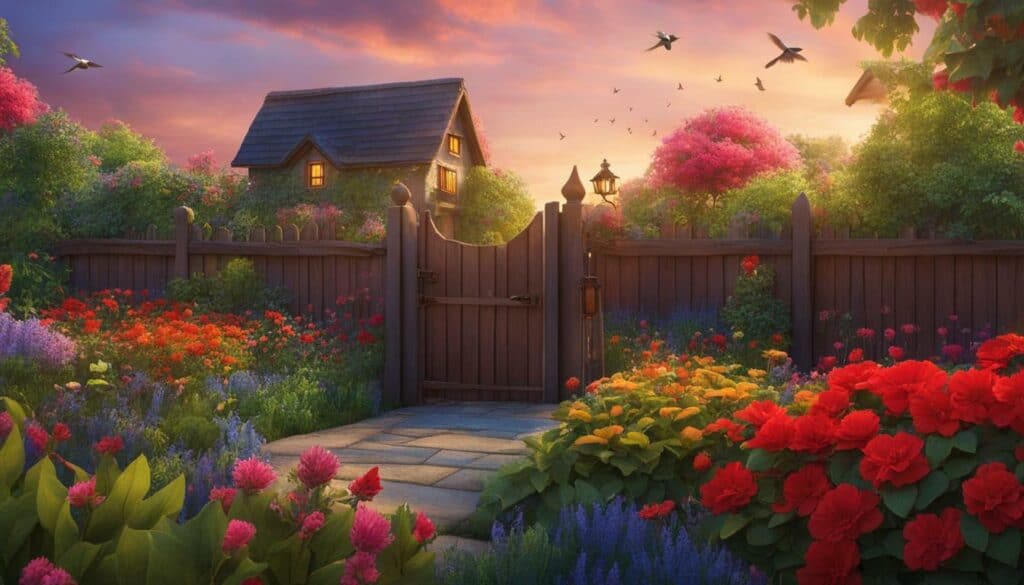
By following these steps, you can create a beautiful garden space that suits your needs and brings joy to both you and the wildlife that shares your garden. Remember that preparing your garden space is an important step in creating a functional and visually appealing outdoor area.
Prioritizing and Progressing
Rather than trying to tackle your entire garden at once, prioritize and progress step by step to ensure the success and enjoyment of your gardening journey. As a beginner, it can be overwhelming to take on too much too soon, so it is important to start with basic garden layouts and beginner-friendly garden ideas.
Begin by assessing the conditions of your garden space, including sunlight and wind patterns, to determine the best type of garden for your yard. Creating functional garden zones based on how you plan to use the space, such as a vegetable garden, dining area, or play area, can also help you prioritize your efforts.
Design principles such as scale, color, and plant groupings can help you create a visually appealing and harmonious garden design. Consider a style that complements your home and create outdoor rooms to make the most of your space.
Before beginning your garden design, it is important to clean up your yard, including edging the garden beds and lawn, applying mulch, and removing any debris. This will create a tidy and well-prepared canvas for your garden designs.
When choosing plants for your garden, assess the conditions of your yard, including sunlight levels and existing plants, to make informed choices. Begin with easy-to-grow plants and progress to more challenging ones as you gain experience.
Remember to prioritize which areas of your garden to focus on first, such as starting with the front yard, and progress at a pace that feels comfortable for you. By following these beginner garden planning tips, you can ensure the success and enjoyment of your gardening journey.
Choosing Plants for Your Garden
Choosing the right plants for your garden is a crucial step in creating a thriving and visually appealing outdoor space. As a beginner, it is important to start by learning about the specific conditions of your garden space. Observing the amount of sunlight different areas receive throughout the day and understanding the level of wind and shelter in your garden will help you decide on the plants that can thrive in your garden.
In addition to these factors, consider the style and purpose of your garden. If you want to have a vegetable garden, choose plants that can yield a plentiful harvest with low-maintenance care. If you want to create a kid-friendly space, choose plants that are safe and non-toxic. If you want to welcome wildlife into your garden, choose native plants that encourage biodiversity.
Prioritize your plant selection based on the available time and budget you have to maintain them. Start with easy-to-care-for plants and gradually introduce new varieties to test your gardening skills.
Remember to maintain your garden space as well. Keeping your garden space clean and mowing the lawn regularly can help you create a beautifully maintained space for your plants to thrive in.
By taking the time to assess the conditions of your garden and planning accordingly, you can select the perfect plants that fit your needs and preferences. Gardening can be a fulfilling and enjoyable hobby, so don’t be afraid to experiment and create the garden of your dreams!
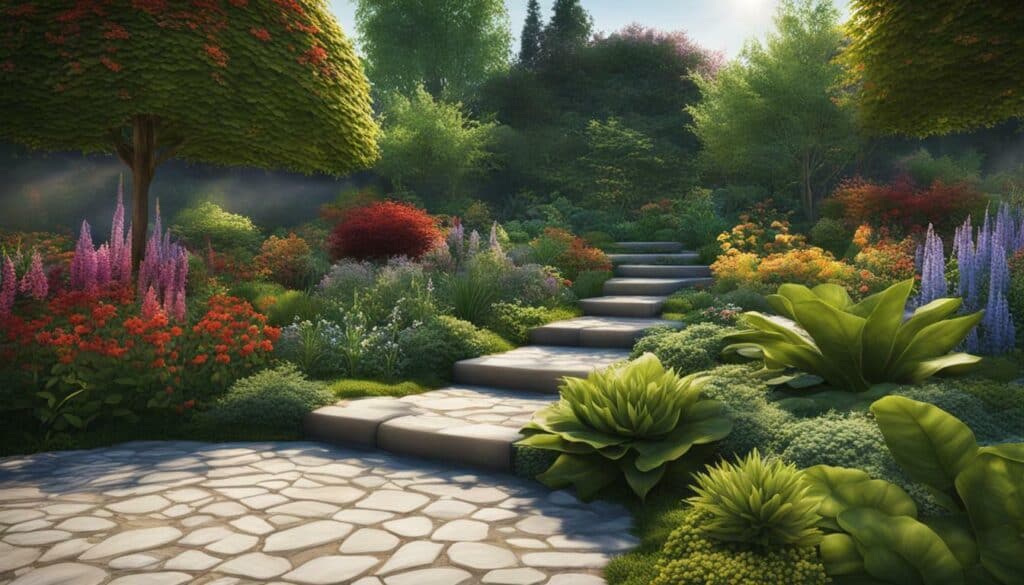
Conclusion
Congratulations! You’re now equipped with the knowledge and inspiration to create beautiful garden designs as a beginner. Embrace nature’s joy and let your green thumb flourish!
To create an easy and simple garden design, it’s important to take the time to learn about your garden space before making any design decisions. Sketching out your ideas and determining the aspect of your garden are helpful in the design process. Understanding the movement of the sun and the areas of sun and shade in your garden will assist in selecting the right plants.
When designing your garden, it’s also essential to consider the use of your space and what features you want to include, such as a vegetable garden, dining area, or play area. Creating a garden that is welcoming for wildlife and incorporating trees are other important aspects to consider in your garden design.
By taking a slow and thoughtful approach to designing your garden, you’ll undoubtedly create a beautiful and functional outdoor space that you’ll love spending time in. Remember, garden designs for beginners don’t need to be complicated or intimidating. With a bit of preparation, planning, and effort, you can achieve a beautiful and easy garden design that you’ll be proud to call your own.
FAQ
Q: What should I consider before designing my garden?
A: Before designing your garden, it’s important to understand your garden space, including its layout and any fixed elements like patios or large trees. You should also determine the aspect of your garden to understand sun and shade patterns, as well as consider the windiness or shelteredness of your garden.
Q: How can I create different zones in my garden?
A: To create different zones in your garden, think about how you want to use the space. You can have a vegetable garden, dining area, play area, and more. By dividing your garden into zones, you can better organize and utilize the space.
Q: How can I make my garden wildlife-friendly?
A: To make your garden wildlife-friendly, avoid using plastic and harmful chemicals. Instead, create a welcoming environment for wildlife by incorporating sustainable practices.
Q: Why should I include trees in my garden?
A: Trees are a great addition to any garden, even in small spaces. They are low maintenance and add beauty to the overall design.
Q: What are the important design principles to consider for my garden?
A: When designing your garden, consider scale, color, and plant groupings. These design principles will help create a visually appealing and harmonious garden.
Q: How can I prepare my garden space?
A: To prepare your garden space, clean up the yard by mowing the lawn, weeding existing garden beds, and edging the lawn and garden beds. You can also mulch the garden beds to create a tidy look and suppress weeds.
Q: How do I prioritize my garden design efforts?
A: It’s important to prioritize your garden design efforts and focus on one area at a time. Starting with the front yard is a popular choice, but you can choose any area you prefer. This will prevent you from feeling overwhelmed and allow you to make progress gradually.
Q: What should I consider when choosing plants for my garden?
A: When choosing plants for your garden, assess the conditions of your garden, including light levels and existing plants. This will help you select appropriate plantings that will thrive in your specific garden environment.
How Can I Implement Your Easy Garden Ideas for Beginners into a Design for My Garden?
Wondering how to incorporate easy gardening tips for beginners into your garden’s design? Start by selecting low-maintenance plants like succulents or herbs. Optimize your space with vertical gardening or raised beds. Embrace container gardening for added flexibility. Remember to group plants with similar watering and sun requirements. Lastly, employ mulching techniques to control weeds and retain moisture.
Source Links
- https://simplysmartgardening.com/garden-design-how-to/
- https://littleterracedhouse.com/2021/04/22/a-beginners-guide-to-designing-a-garden/
- https://www.houzz.com/magazine/10-tips-to-start-a-garden-can-do-ideas-for-beginners-stsetivw-vs~11308212
- https://www.countryliving.com/gardening/garden-ideas/g746/garden-plans/
- https://www.thespruce.com/landscape-design-for-beginners-2130815
- https://www.gardenfundamentals.com/sun-mapping-garden/
- https://empressofdirt.net/light-conditions/
- https://www.bhg.com/gardening/landscaping-projects/landscape-basics/landscape-design-for-beginners/
- https://www.almanac.com/over-20-vegetable-garden-layout-ideas
- https://www.homesandgardens.com/advice/how-to-plan-a-garden
- https://www.housebeautiful.com/uk/garden/designs/a495/garden-design-ideas/
- https://www.housebeautiful.com/uk/garden/designs/a39171523/wild-garden/
- https://www.fernsfeathers.ca/blog-1-1/planning-a-wildlife-garden
- https://www.idealhome.co.uk/garden/garden-ideas/wildlife-garden-ideas-224133
- https://www.coohom.com/article/the-art-of-trees-exploring-garden-art-and-zen-gardens
- https://www.coohom.com/article/the-beauty-and-benefits-of-trees-in-garden-structures-and-entertainment-areas
- https://arbordayblog.org/landscapedesign/designing-a-landscape-with-trees/
- https://www.prettypurpledoor.com/garden-design-principles/
- https://www.thespruce.com/color-theory-in-landscape-design-2132147
- https://www.almanac.com/small-vegetable-garden-plans-and-layouts
- https://www.houseandgarden.co.uk/gallery/designing-a-garden
- https://www.hgtv.com/outdoors/outdoor-remodel/figuring-out-landscaping-priorities
- https://www.realhomes.com/advice/how-to-choose-plants-for-your-garden
- https://www.davislandscape.com/blog/plants-for-landscape-design/
- https://www.almanac.com/landscape-design-ideas-and-advice-beginners
- https://content.ces.ncsu.edu/extension-gardener-handbook/19-landscape-design

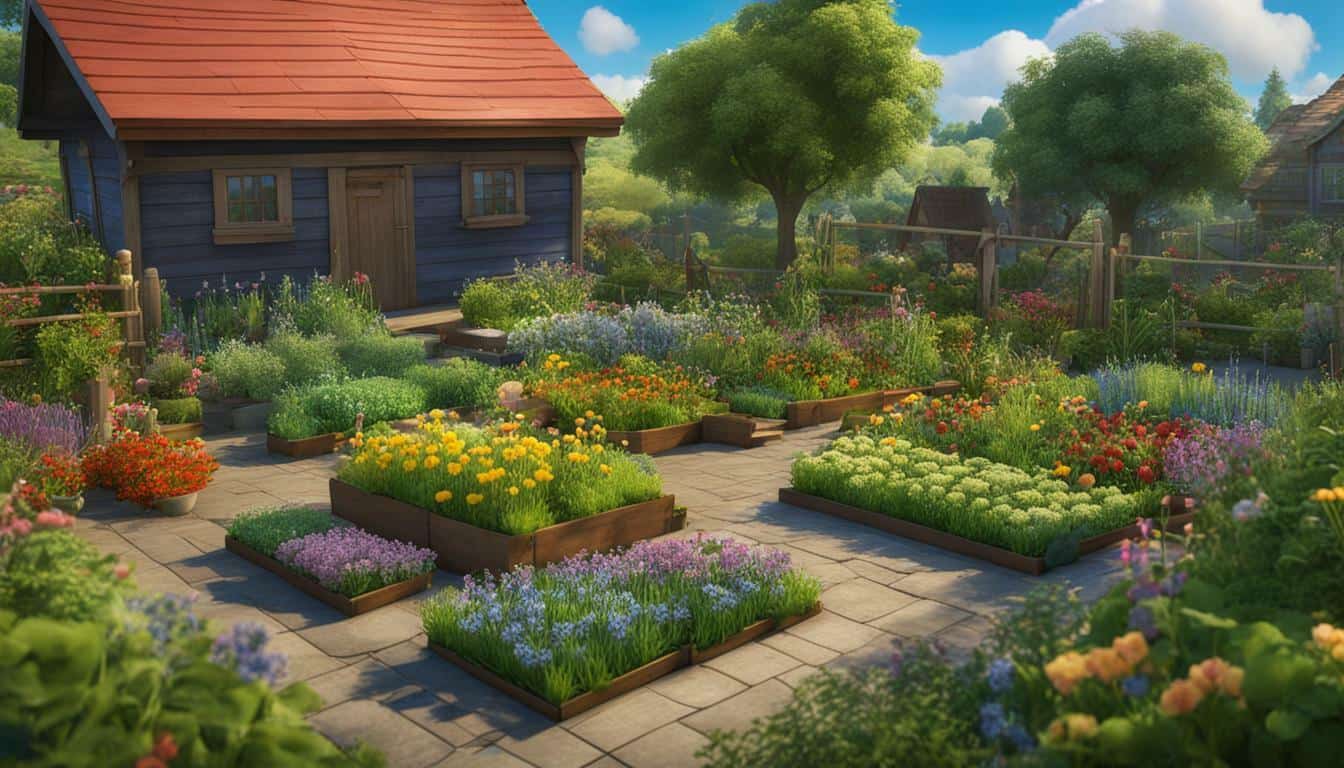



Leave a Reply